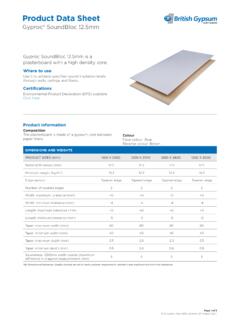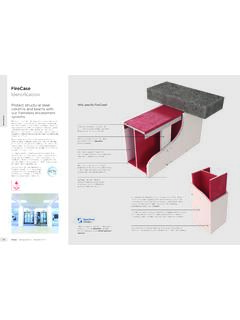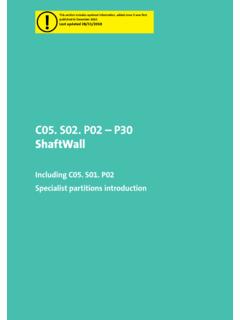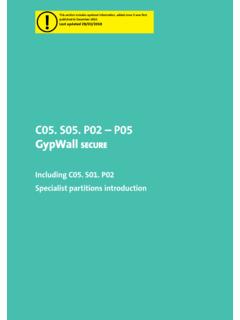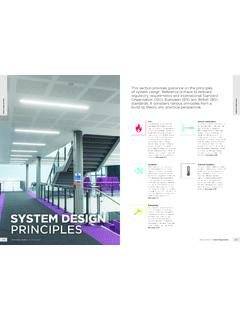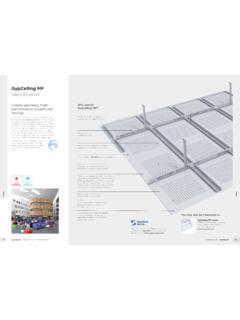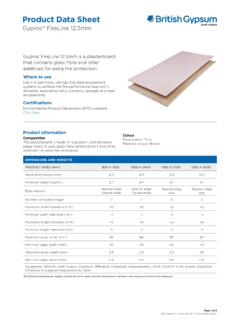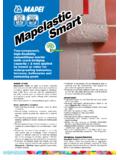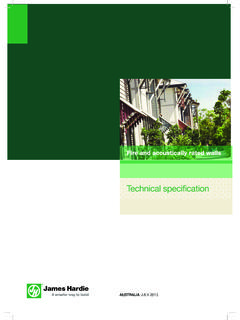Transcription of Gyproc Moisture Resistant - british-gypsum.com
1 Gyproc Moisture ResistantProduct Data SheetIntroductionSuitable as a base for tiling in wet use areas. Also used for external soffits in sheltered descriptionGypsum plasterboard with water repellent additives in the core and paper liners. Gyproc Moisture Resistant consists of an aerated gypsum core with water repellent additives encased in, and firmly bonded strong paper liners. Gyproc Moisture Resistant is a plasterboard that is suitable for drylining internal surfaces. This plasterboard is one of the products within our plasterboard range that is certified to BES 6001 achieving a rating of Very Good .Board performanceFire protectionPlasterboard linings provide good fire protection owing to the unique behaviour of the non-combustible gypsum core when subjected to high temperatures.
2 For the purposes of the national Building Regulations, plasterboard is designated a material of limited combustibility (Approved Document B). The surfaces of Gyproc Moisture Resistant are designated Class 0 (for the purposes of national Building Regulations). Please refer to the table resistancePlease refer to the appropriate White Book product or systems section for information on the fire resistance of building elements lined with Gyproc Moisture to fire test performanceThermal conductivity Gyproc Moisture Resistant - of temperatureGyproc Moisture Resistant is unsuitable for use in areas subject to continuously damp or humid conditions and must not be used to isolate dampness.
3 Plasterboards are not suitable for use in temperatures above 49 C but can be subjected to freezing conditions without risk of damage. Effect of condensationThe thermal insulation and ventilation requirements of national Building Regulations aim to reduce the risk of condensation and mould growth in new buildings. However, designers should take care to eliminate all possibility of problems caused by condensation, particularly in refurbishment colour Green face paper Green reverse side paperBoard printingFace - screw centre markings x . Edge - product code, EAN number, board thickness x width x length, edge type. Reverse - standard and range T/E = Tapered Edge S/E = Square Edge Board typesT/E - with Gyproc jointing materials for taped and filled - with undecorated applications or as a base for ceramic and installationGeneralIt is important to observe appropriate health and safety legislation when working on site personal protective clothing and equipment, etc.
4 The following notes are intended as general guidance only. In practice, consideration must be given to design criteria requiring specific project off-loading of this product should be carried out with care to avoid unnecessary strain. For further information please refer to the Manual Handling section of the Site Book or Manual Handling Guide, available to download from CuttingThis product may be cut using a plasterboard saw or by scoringwith a sharp knife and snapping the board over a straight for switch or socket boxes should be cut out before theboards are fixed using a utility saw or sharp knife. When cutting boards, power and hand tools should be used with care and in accordance with the manufacturers recommendations.
5 Power tools should only be used by people who have been instructed and trained to use them safely. Appropriate personal protective equipment should be used. 1 Product Data Sheet PDS-011-03 StandardPerformanceBS 476: Part 6: 1989 Method of test for fire propagation for of performance (I) not exceeding 12 and a sub-index (i1) not exceeding 476: Part 7: 1997 Surface spread of flame tests for 1 (both sides).EN 520: 2004, A1 without further testing as A2-s1, mmLength mmEdge Board120024002700, 3000Kg/m2 = R (m2K/W) = S/ET/E15mm Board12002400Kg/m2 = R (m2K/W) = British Gypsum January 2014 PDS-011-03 EMS 543324FM 550533 Telephone: 0844 800 1991 Fax: 0844 561 8816 Email: enquiries: 0844 561 8810 Product standardsEN 520: 2004, A1 2009 Gypsum Plasterboards, definitions, requirements and test methodsType A: Gypsum plasterboard.
6 Plasterboard with a face to which suitable decoration may be H1: Plasterboard with reduced water absorption rate. Boards which have additives to reduce the water absorption rate. They may be suitable for special applications in which reduced water absorption properties are required to improve the performance of the board. For the purposes of identification, these boards are designated Type H1, H2 and H3, with different water absorption damage - Lightly sand the surface to remove burrs and fill flush with Gyproc Easi-Fill or Gyproc Easi-Fill 45, or two applications of Gyproc Joint Cement. When dry, apply Gyproc Drywall Primer or Gyproc Drywall Sealer to leave the surface ready for indents resulting from impact - Check the plasterboard core to ensure that it is not shattered.
7 If intact, apply a coat of Gyproc Joint Filler, or Gyproc Easi-Fill or Gyproc Easi-Fill 45, followed by the procedure for repairing minor damage as outlined above, once set / core and / or broken edges (non-performance situations only) - Remove the damaged area of core. Score the liner approximately 10mm away from the sound plaster aroundthe damaged area, and peel the paper liner away. Apply Thistle GypPrime or PVA to seal the core and surrounding liner. Bulk fill the hole with a stiff mix of Gyproc Easi-Fill or Gyproc Easi-Fill 45, or Gyproc Joint Filler, and strike off flush. Apply Gyproc Easi-Fill or Gyproc Easi-Fill 45, or two applications of Gyproc Joint Cement, once the filler is set / dry.
8 When dry, apply Gyproc Drywall Primer or Gyproc Drywall Sealer (only suitable in non-performance damage - When the damage is more extensive, it may be necessary to replace that area of plasterboard. It is important that the replacement board is of the same type as specified and installed. Cut out the affected area back to the nearest framing member. Replace the plasterboard, accurately cutting and screw fixing the same type and thickness of plasterboard. Fill edge joints, then tape and finish in the recommended way. Treat the finished surface with Gyproc Drywall Primer or two coats of Gyproc Sealer, if previously specified for vapour control purposes. Redecorate as and installationJointing Gyproc jointing materials produce durable joint reinforcement and a smooth, continuous, crack- Resistant surface ready for priming and final decoration.)
9 A number of jointing specifications are available to suit the board type, method of application, and site boards with decorative side out to receive joint treatment or a skim plaster finish. Lightly butt boards together. Never force boards into position. Install fixings not closer than 13mm from cut edges and 10mm from bound edges. Position cut edges to internal angles whenever possible, removing paper burrs with fine sandpaper. Stagger horizontal and vertical board joints between layers by a minimum of 600mm. Locate boards to the centre line of framing where this supports board edges or plastering should not normally be specified to Gyproc Moisture Resistant and MR grade boards.
10 These types of board are intended for use in environments of higher than normal humidity for which no gypsum plaster is designed to be suitable. Where Moisture Resistant board options are used in shell and core construction to provide temporary resistance to high Moisture conditions, they can be skimmed at a later date after the building envelope has been made weather-tight. Plaster should be applied only to the face of Moisture Resistant boards and pre-treatment with ThistleBond-it is the joint treatment has dried, decoration, including any decorator s preparatory work, should follow with the minimum delay. Gyproc , Thistle , Gypframe and Glasroc are all registered trademarks of BPB United Kingdom Limited.
